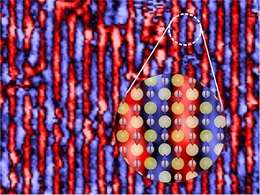Scientists in search of explanation of high-temperature superconductivity

Science may be a step closer to solving one of the outstanding mysteries of solid state physics after an international team of researchers achieved atomic-scale imaging of the magnetic structure in the parent compound of an unconventional superconductor.
Superconductors are extraordinary materials which under certain conditions, usually very low temperatures, can conduct electricity without any energy losses. Although superconductivity was first observed over 100 years ago, science still can't explain exactly why some materials behave this way.
The search for an explanation for this so-called "high temperature" superconductivity and a means of making superconductors work at room temperature is considered the Holy Grail of condensed matter physics. Lossless power transmission would revolutionise mankind's use of energy.
Now a team of researchers, led by Dr Peter Wahl of the University of St Andrews in Scotland, has shed new light on the behaviour of high-temperature superconductors, discovered around 30 years ago. Unlike conventional superconductors which only function at incredibly low temperatures, high temperature superconductors work around about or above the boiling point of liquid nitrogen or minus 196°C. Still very cold – but boiling hot in the strange world of superconductivity.
From the beginning, it was clear that superconductivity in these materials is driven by a mechanism different from the one in "normal" superconductors, where lattice vibrations have been identified as the enabler of superconductivity. Magnetism or better fluctuations of magnetic order appear to play an important role for the unconventional superconductivity.
Dr Wahl and his colleagues from the Max Planck Institute for Solid State Research and University of Ausburg in Germany used ultra- low temperature scanning tunneling microscopes which operate only a few hundreds of a degree above absolute zero.
In these microscopes, the surface of the material is probed with a tip which hovers only a distance of a few atomic radii above the material. To enable magnetic imaging, the researchers had to apply a trick: rather than covering the tip with magnetic material, a technologically demanding process, they picked up some magnetic material from the surface – almost like a vacuum cleaner but with the magnetic material sticking to the end of the tip.
"With this novel approach, we hope to shed new light into the mysteries of unconventional superconductivity, by being able to directly visualize both magnetic order and detect superconductivity in the same measurement," said Dr Wahl. The researchers were able to image the magnetic order in iron tellurium, the parent compound of an iron-based superconductor, at the atomic scale.
Dr Wahl's research will be boosted by the construction of a new cutting edge ultra-low vibration (ULV) facility in the School of Physics and Astronomy at St Andrews. The ULV lab represents an investment of more than £2 million for the University of St Andrews and is expected to be completed early next year.
First results of the team's experiments are published today in Science Express.
Journal information: Science Express
Provided by University of St Andrews




















